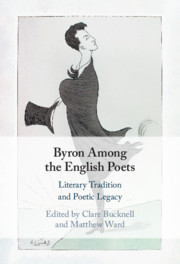Book contents
- Byron Among the English Poets
- Byron Among the English Poets
- Copyright page
- Dedication
- Contents
- Contributors
- Acknowledgements
- Abbreviations
- Introduction
- Part I Inheritances
- Part II Contemporaries
- Part III Afterlives
- Chapter 14 In-Between Byrons: Byronic Legacies in Women’s Poetry of the Late Romantic to Mid-Victorian Era
- Chapter 15 Byron and Browning: Something and Nothing
- Chapter 16 Arnold’s Ambivalence and Byron’s Force and Fire
- Chapter 17 A. C. Swinburne and Byron’s Bad Ear
- Chapter 18 What Auden Made of Byron
- Chapter 19 Byronic Inflections in British Poetry since 1945
- Chapter 20 Byron Among Our Contemporaries
- Index
Chapter 17 - A. C. Swinburne and Byron’s Bad Ear
from Part III - Afterlives
Published online by Cambridge University Press: 22 July 2021
- Byron Among the English Poets
- Byron Among the English Poets
- Copyright page
- Dedication
- Contents
- Contributors
- Acknowledgements
- Abbreviations
- Introduction
- Part I Inheritances
- Part II Contemporaries
- Part III Afterlives
- Chapter 14 In-Between Byrons: Byronic Legacies in Women’s Poetry of the Late Romantic to Mid-Victorian Era
- Chapter 15 Byron and Browning: Something and Nothing
- Chapter 16 Arnold’s Ambivalence and Byron’s Force and Fire
- Chapter 17 A. C. Swinburne and Byron’s Bad Ear
- Chapter 18 What Auden Made of Byron
- Chapter 19 Byronic Inflections in British Poetry since 1945
- Chapter 20 Byron Among Our Contemporaries
- Index
Summary
In 1881, Arnold concluded that, of the century’s poets, ‘Wordsworth and Byron stand out by themselves’.1 The judgement was a little more surprising then than it seems now, because the reputations of both were if not in eclipse then at least overshadowed. Between 1840 and 1870 it was the fashion, according to John Nichol, to talk of Byron as ‘a sentimentalist, a romancer, a shallow wit, a nine days’ wonder, a poet for “green, unknowing youth”’.2 After Wordsworth died a fund was established to raise a memorial to him, but it was less successful than had been hoped. Macaulay commented that ‘ten years earlier more money could have been raised in Cambridge alone’. Arnold tells that story in 1879, in the preface to his selection of Wordsworth’s poems, and it was that volume that did most to re-establish Wordsworth’s reputation.3 There were more hands involved in salvaging Byron’s. In 1870, Alfred Austin published The Poetry of the Period, in which all the century’s poets are compared with Byron and found wanting, and in the same year John Morley brought out his essay on Byron as the poet of the French Revolution in the Fortnightly Review.4 Ten years later, John Nichol published the volume on Byron in Morley’s English Men of Letters series from which I have already quoted. But the first sign that a revival in Byron’s fortunes might be under way came in 1866, when Swinburne published his Selection from the Works of Lord Byron.5
- Type
- Chapter
- Information
- Byron Among the English PoetsLiterary Tradition and Poetic Legacy, pp. 287 - 302Publisher: Cambridge University PressPrint publication year: 2021



